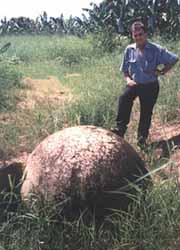|
|||
 |
|
Editorial
|
Press Releases
|
Book Reviews
|
Fragments
Atlantis in America
|

|
| Ivar Zapp standing astride one of the hundreds of stone spheres dotting the landscape around the Diquis Delta region of Costa Rica. Authors Zapp and Erikson believe that these stone spheres, which point to major neolithic sites around the world, sat at the heart of a major maritime culture. Image from Atlantis in America. |
 undreds of books and articles have been written on the subject of Atlantis since Ignatius Donnelly came out with his seminal work,
Atlantis: The Antediluvian World
in 1882. Theories on the location of Atlantis have ranged anywhere from Antarctica to outer space, and have varied in quality from well documented, well reasoned scholarly works to utter nonsense. Fortunately, Ivar Zapp and George Erikson's
Altantis in America
rates well on the academic side of that scale, being one of the best Atlantis books to be found in the field of Atlantology today.
undreds of books and articles have been written on the subject of Atlantis since Ignatius Donnelly came out with his seminal work,
Atlantis: The Antediluvian World
in 1882. Theories on the location of Atlantis have ranged anywhere from Antarctica to outer space, and have varied in quality from well documented, well reasoned scholarly works to utter nonsense. Fortunately, Ivar Zapp and George Erikson's
Altantis in America
rates well on the academic side of that scale, being one of the best Atlantis books to be found in the field of Atlantology today.
The modern science of archaeology began in fits and starts during the nineteenth century largely due to the initiative of such controversial figures as Heinrich Schliemann, who rediscovered the city of Troy in 1871, and Sir Flinders Petrie who was the first to carefully measure the pyramids. Since then, archaeology has solidified as a science, which is a good thing in that much more care is now taken when excavating sites. However, over the last few decades archaeology has become so introverted that it has begun to lose its relevance, seemingly more interested in confirming preset notions about how things happened, instead of searching for the truth in a truly unbiased fashion, as is the heart of true science. As a result, increasingly in the last few decades, major new discoveries have been made not by academics, but by independent archaeologists and researchers.
Such is the case with Zapp and Erikson, who have clearly done their homework on the subject. Not only have they carefully researched the history, presuppositions, and current trends in the archaeology of the Americas, but they also bring original discoveries to back up their scholarship. Their thesis is that Atlantis was located in the Americas, specifically, around Central America. Their "Atlantis in the Americas" theory is based not only on the highly developed architecture of the Aztecs, Maya, Inca and other ancient cultures of the Americas, but also on evidence of an ancient, sophisticated maritime civilization.
As one of the proofs that Central America was once the seat of an ancient maritime culture, Zapp offers the discovery of hundreds of stone spheres in the Diquis Delta region of Costa Rica that he believes were once part of an elaborate navigational "school". In this school, Zapp theorizes, sailors were taught how to determine their location on the sea based upon the relative locations of the sun, moon and stars. The spheres, he found, were precisely machined to within a thousandth of an inch of perfect sphericity, measured up to nine feet in diameter and weighed as much as 20 tons, which is unusual in and of itself. However, after closer examination, Zapp found that the spheres, that were typically arranged in sets of three, were so aligned as to point at various other megalithic sites around the world including the Pillars of Hercules, the Pyramids, Stonehenge, and Easter Island, among others. Some were also aligned perfectly north and south, and altogether, it became clear after some research, these stones could be used as a navigation teaching aid even today.
Zapp and Erikson decided to study the history of the area more carefully and see if these ancient Americans had any substantial knowledge of sailing. In fact, they had mastered the use of light, sturdy balsa rafts, that they could (and did) use to travel long distances. Much of this knowledge, however, and a lot more, was suppressed or destroyed by the Catholic church after the Conquistadores conquered Central America, but enough still survives for us to learn that the native inhabitants of the area were in fact highly sophisticated astronomers, mathematicians, architects, sailors, and theologians, among other things. Their theological beliefs, of course, posed a threat to the Catholic church, whose understanding of science at the time was actually inferior to that of the Aztecs. Therefore, in their eyes, destruction of Central American history, culture, and sciences became an imperative.
Not satisfied with displaying a mastery of American archaeology, Zapp and Erikson then go on to display a mastery of astronomy, history and anthropology to build a case for Atlantis in the Americas. Though it much more likely that Atlantis was actually what is now known as the Azores, Zapp and Erikson still argue very convincingly their case for an Atlantis centered somewhere in or around Central America. Their case is particularly strong because, as Edgar Cayce believed, the Caribbean and Central America were actually once part of Atlantis. However, Cayce also believed that these areas were actually westernmost islands and provinces of Atlantis, and not the continent of Atlantis itself, which he, like Plato, located in the Atlantic. Central America and the Caribbean also do not fit some of the criteria set forth by Plato, including the fact that they are not located in front of the Pillars of Hercules, they are not a large island the size of Libya and Asia, and they did not sink beneath the waves, though parts of them may have since the end of the last Ice Age. However, that area is definitely one of the areas that the Atlanteans fled to after their islands began to sink, so the argument that these structures were Atlantean in origin is probably correct. It would be more accurate to say not that Atlantis was centered in Central America, but that Central America was part of the Atlantean culture, most likely one of its largest and most important provinces. Plato and Cayce both said that the main island was in the Atlantic, but that the Atlanteans held sway over many lands to the west of that island, which obviously points to central America and the Caribbean.
Actually much more interesting than the Atlantis theory itself, however, is the wealth of information about the ancient Americas that the
authors bring together in a well-organized fashion. Fans of ancient history, archaeology, mythology, anthropology, and related types of information about the Americas will be well rewarded by a thorough read of this excellent book.
Add it to your library today,
and help independent researchers like Zapp and Erikson find out the real truth about our most ancient history. 

![]()
 Atlantis in America: Navigators of the Ancient World
Atlantis in America: Navigators of the Ancient World
Ivar Zapp, George Erikson (Editor)
Rating:




Increasingly in the last few decades, major new discoveries have been made not by academics, but by independent archaeologists and researchers.
Such is the case with Zapp and Erikson, who have clearly done their homework on the subject. Not only have they carefully researched the history, presuppositions, and current trends in the archaeology of the Americas, but they also bring original discoveries
to back up their scholarship. Their thesis is that Atlantis was located in the Americas, specifically, around Central America. Their "Atlantis in the Americas" theory is based not only on the highly developed architecture of the Aztecs, Maya, Inca and other ancient cultures of the Americas, but also on evidence of an ancient, sophisticated maritime civilization. Actually much more interesting than the Atlantis theory itself, however, is the wealth of information about the ancient Americas that the authors bring together in a well-organized fashion. Fans of ancient history, archaeology, mythology, anthropology, and related types of information about the Americas will be well rewarded by a thorough read of this excellent book.
Click
here
to buy this book.
 Finding the Walls of Troy: Frank Calvert and Heinrich Schliemann at Hisarlik
Finding the Walls of Troy: Frank Calvert and Heinrich Schliemann at Hisarlik
Susan Heuck Allen
The relentlessly self-promoting amateur archaeologist Heinrich Schliemann took full credit for discovering Homer's Troy over one hundred years ago, and since then generations have thrilled to the tale of his ambitions and achievements. But Schliemann gained this status as an archaeological hero partly by deliberately eclipsing the man who had launched his career. Now, at long last, Susan Heuck Allen puts the record straight in this fascinating archaeological adventure that restores the British expatriate Frank Calvert to his rightful place in the story of the identification and excavation of Hisarlk, the site now thought to be Troy as described in the Iliad. Frank Calvert had lived in the Troadin the northwest corner of Asia Minorexcavating there for fifteen years before Schliemann arrived and learning the local topography well. He was the first archaeologist to test the hypothesis that Hisarlk was the Troy of Hector and Helen. So that he would have unrestricted access to the site, he purchased part of the mound and was the first archaeologist to conduct excavations there. Running out of funds, he later interested Schliemann in the site. The thankless Schliemann stole Calvert's ideas, exploited his knowledge and advice, and finally stole Calvert's glory, in part by slandering him and denigrating his work. Allen corrects the record and does justice to a man who was a victim of his own integrity while giving a balanced treatment of Schliemann's true accomplishments. This meticulously researched book tells the story of Frank Calvert's development as an archaeologist, his adventures and discoveries. It focuses on the twists and turns of his turbulent relationship with the perfidious Schliemann, the resulting gains for archaeology, and the successful conclusion of their common quest. Allen has brought together a wide range of relevant published material as well as unpublished sources from archives, diaries, letters, and personal interviews to tell this gripping story.
Click
here
to buy this book.
 Flinders Petrie: A Life in Archaeology
Flinders Petrie: A Life in Archaeology
Margaret S. Drower
Written by an Egyptologist, this meticulously documented biography records the life and work of the legendary British Egyptologist (1853-1942) whose exemplary scientific fieldwork provided the foundation for modern Egyptology. Drower draws upon a wide range of sources to trace Petrie from his childhood in England through a long, magnificent career that set new standards in recording finds, establishing principles of dating pottery, treatment of workers, and standards of ethics in archaeology. A man of robust health and enormous energy, he had the great good fortune of marrying the perfect partner in Hilda Urlin, his indefatigable coworker. Excerpts from letters and diaries allow charming insights into Petrie's notoriously spartan life on the site.
Click
here
to buy this book.
Editorial
|
Press Releases
|
Book Reviews
|
Fragments
Effigy Mounds II
|
Sea Serpents IV
|
Atlantis IV
Register
for our new Hall of Records Newsletter!
Questions? Comments? Suggestions? Advertising? Press Releases?
Contact us!

|




